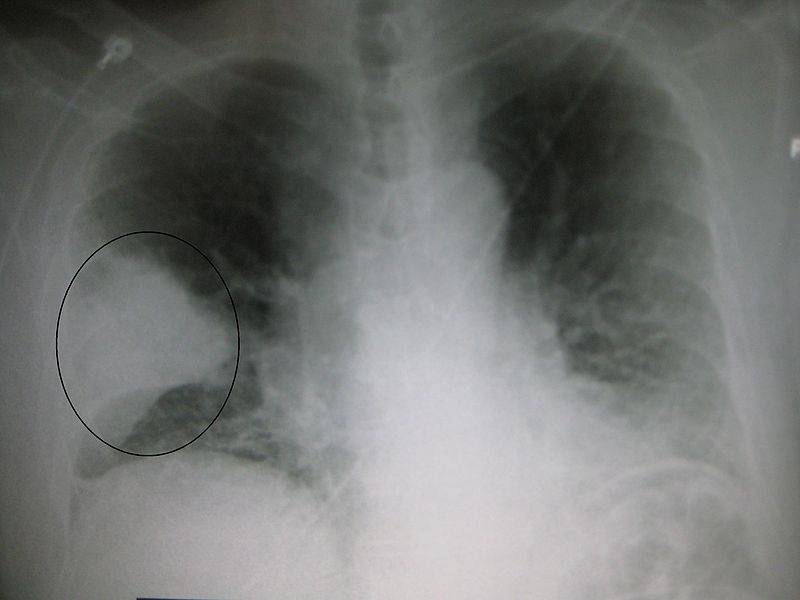Key Difference – Lobar Pneumonia vs Bronchopneumonia
Invasion of the lung parenchyma by a disease-causing agent (mostly bacteria) evokes exudative solidification of the (consolidation) of the pulmonary tissue known as pneumonia. According to the localization of the inflammatory foci, pneumonia is divided into two main subcategories as lobar pneumonia and bronchopneumonia. When the infection is confined to only one or few lobes of lungs that is known as lobar pneumonia. On the other hand, bronchopneumonia is the inflammation of lung parenchyma that arises from bronchi or bronchioles secondary to an infection. Accordingly, the key difference between the two forms is that in lobar pneumonia, the inflammation is confined to one lobe but in bronchopneumonia inflammatory foci are present throughout the lungs without any localization.
CONTENTS
1. Overview and Key Difference
2. What is Pneumonia
3. What is Lobar Pneumonia
4. What is Bronchopneumonia
5. Similarities Between Lobar Pneumonia and Bronchopneumonia
6. Side by Side Comparison – Lobar Pneumonia vs Bronchopneumonia in Tabular Form
7. Summary
What is Pneumonia?
The invasion of the lung parenchyma by a disease-causing agent, mostly bacteria evokes exudative solidification of the (consolidation) of the pulmonary tissue known as pneumonia.
Classification of pneumonia is based on several criteria.
Pathogenesis
The normal lung is devoid of any disease-causing organisms or substances. The respiratory tract has several defense mechanisms aimed at preventing the entry of these disease-causing agents.
- Nasal clearance – particles deposited in the front of the airway on the non-ciliated epithelium are normally removed by sneezing or coughing. The particles deposited posteriorly are swept over and will be swallowed.
- Tracheobronchial clearance- this is accompanied by mucociliary action
- Alveolar clearance- phagocytosis by alveolar macrophages.
Pneumonia can result whenever these defenses are impaired, or the host resistance is decreased. Factors such as chronic diseases, immuno suppression and use of immunosuppressive drugs, leukopenia, and viral infections affect the host resistance making the host vulnerable to get this kind of disorders.
The clearance mechanisms can be damaged in several ways,
- Suppression of the cough reflex and the sneezing reflex
Secondary to coma, anesthesia or neuromuscular diseases.
- Injury to the mucociliary apparatus
Chronic smoking is the major reason for the destruction of the mucociliary apparatus.
- Interference with the phagocytic action
- Pulmonary congestion and edema
- Accumulation of pulmonary secretions in conditions such as cystic fibrosis and bronchial obstruction.
What is Lobar Pneumonia?
When the infection is confined to only one or few lobes of lungs that is known as lobar pneumonia.Main causative agents are pneumococci, klebsiella, staphylococci, streptococci.
Morphology
Four stages of inflammatory response have classically been described.
- Congestion
The lung is heavy, boggy, and red.This stage is characterized by vascular engorgement, intra -alveolar fluid with few neutrophils, and often the presence of numerous bacteria.
- Red hepatization
Congestion is followed by red hepatization that is characterized by massive confluent exudation with red cells, neutrophils, and fibrin filling the alveolar spaces.
- Gray hepatization
In the gray hepatization stage because of the progressive disintegration of the red blood cells that have accumulated in the alveolar spaces, lungs assume a gray color. This grayish appearance is enhanced by the presence of the fibrino suppurative exudate.
- Resolution
During the final stage of the pathogenesis, the consolidated exudate that has accumulated within the alveolar spaces undergoes progressive enzymatic digestion to produce granular semi-fluid debris that is reabsorbed and ingested by macrophages or coughed up.
Complications
- Abscess – as a result of the tissue destruction and necrosis
- Empyema- as a result of the infection spreading into the pleural cavity
- Organization
- Dissemination into the bloodstream.
Clinical Features
- Acute onset of fever
- Dyspnea
- Productive cough
- Effusion
- Pleural friction rub
- Chest pain
Investigations
- Chest X-ray shows the areas of consolidation and can provide useful clues to identify the causative agent.
- Sputum for culture and gram staining
- Bronchoscopy can be performed when a malignancy or an obstruction in the respiratory tract is suspected.

Figure 01: Chest x-ray appearance in Lobar Pneumonia
Management
Empirical antibiotic therapy can be started after taking the samples for investigations. The prescribed antibiotics are subjected changes when the antibiotic sensitivity test and culture results are available. Ventilatory support should be given to the patients with severe breathing difficulties.
What is Bronchopneumonia?
Bronchopneumonia is the inflammation of lung parenchyma that arises from bronchi or bronchioles secondary to an infection. Staphylococci, Streptococci, Pneumococci, Haemophilus, and Pseudomonas auregenosa are the main causative agents.

Figure 02: An infected lung with Bronchopneumonia
Morphology
- Foci of bronchopneumonia are consolidated areas of acute suppurative inflammation. The consolidation may be patchy through one lobe but is more often multilobar and frequently bilateral.
What are the Similarities Between Lobar Pneumonia and Bronchopneumonia?
- Both conditions are due to the inflammation of pulmonary parenchyma secondary to an infection.
- Clinical features, investigations performed and management of both conditions are the same.
What is the Difference Between Lobar Pneumonia and Bronchopneumonia?
Lobar Pneumonia vs Bronchopneumonia | |
| When the infection is confined to only one or few lobes of lungs that is known as lobar pneumonia. | Bronchopneumonia is the inflammation of lung parenchyma which arises from bronchi or bronchioles secondary to an infection. |
| Causative Agents | |
| Main causative agents are pneumococci, klebsiella, staphylococci, streptococci. | Staphylococci, Streptococci, Pneumococci, Haemophilus, and Pseudomonas auregenosa are the main causative agents. |
| Impact of the Inflammation | |
| Inflammation is confined to one or more lobes. | Inflammation is not localized, and there are multiple inflammatory foci. |
Summary – Lobar Pneumonia vs Bronchopneumonia
When the infection is confined to only one or few lobes of lungs that is known as lobar pneumonia. Bronchopneumonia is the inflammation of lung parenchyma that arises from bronchi or bronchioles secondary to an infection.As given in their definitions, lobar pneumonia is confined to one or few lobes, but bronchopneumonia affects a wide area of the lungs without any localization.
Download the PDF of Lobar Pneumonia vs Bronchopneumonia
You can download the PDF version of this article and use it for offline purposes as per citation note. Please download the PDF version here: Difference Between Lobar Pneumonia and Bronchopneumonia
Reference:
1.Kumar, Parveen J., and Michael L. Clark. Kumar & Clark clinical medicine. Edinburgh: W.B. Saunders.
Image Courtesy:
1.’PneumonisWedge09’By James Heilman, MD – Own work, (CC BY-SA 3.0) via Commons Wikimedia
2.’Bronchopneumonia lung’By Yale Rosen (CC BY-SA 2.0) via Commons Wikimedia
ncG1vNJzZmivp6x7pbXFn5yrnZ6YsqOx07CcnqZemLyue8OinZ%2Bdopq7pLGMm5ytr5Wau264zpuYq2Wgo7K2uc6noJplkaOxbsLSZpmrp56YtbC8zZ6spqeenq5w